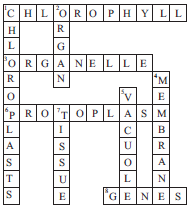Cell (Biology) Class 8 - NCERT Questions
Indicate whether the following statements are True (T) or False (F).
(A) Unicellular organisms have one-celled body.
(B) Muscle cells are branched.
(C) The basic living unit of an organism is an organ.
(D) Amoeba has irregular shape.
(A) T (B) T (C) F (D) T
Q 2.Make a sketch of the human nerve cell. What function do nerve cells perform?
SOLUTION: 
Functions : Nerve cell receives and transfers messages from various body parts to brain and brain to various parts of the body thus they help to control and coordinate the working of different parts of the body.
Write short notes on the following.
(A) Cytoplasm
(B) Nucleus of a cell
(A) Cytoplasm : The cytoplasm is a jelly-like substance present between the cell membrane and the nucleus. Various components, or cell organelles such as mitochondria, endoplasmic reticulum, Golgi body, lysosome, plastids, etc. are present in the cytoplasm. It is made up of carbohydrates, proteins and water. All life functions such as synthesis of substance, secretion of substance, digestion of substance to generate energy etc. take place in cytoplasm.
(B) Nucleus of a cell : The nucleus is centrally located, and is the major functional centre of the cell. It may be spherical or oval in shape. It is surrounded by an envelope known as the nuclear membrane. Pores, present at intervals, have the effect of perforating the envelope. The liquid present in the nucleus is known as nucleoplasm and is enclosed by a nuclear membrane. It is the nuclear pores that make possible the exchange of materials between cytoplasm and nucleoplasm. The nucleoplasm contains the nucleolus and chromatin material.
The nucleolus helps in protein synthesis. This is where ribosome formation takes place. Chromatin material is thin, thread-like mass of chromosome material. It is composed of the genetic substance known as DNA, which has a major role to play in heredity, since it transmits information from one generation to the next.
The function of nucleus is to control all metabolic activities of the cell, take part in cell division and transmit hereditary characters from one generation to the next.
Which part of the cell contains organelles?
SOLUTION:Refer answer 3(A).
Q 5.Make sketches of animal and plant cells. State three differences between them.
SOLUTION: 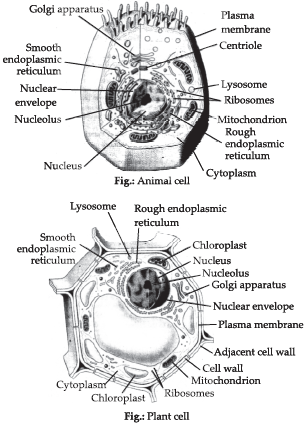
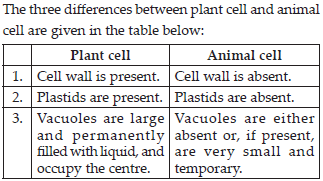
State the difference between prokaryotes and eukaryotes.
SOLUTION:The differences between prokaryotes and eukaryotes are given in the table below:
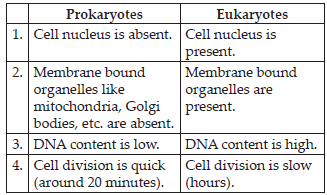
Where are chromosomes found in a cell? State their function.
SOLUTION:In an eukaryotic cell chromosomes are found inside the nucleus, while in a prokaryotic cell chromosomes lie naked in the cytoplasm. Chromosomes are made up of DNA. Genes are sub-units of DNA. They contain all the information needed by the cell to function and to reproduce further cells of the next generation. Thus, genes (chromosomes) are responsible for inheritance, i.e. transfer of characteristics from the parents to the offspring.
Q 8.‘Cells are the basic structural units of living organisms’. Explain.
SOLUTION:Cell is a basic unit of life as no living organism can have life without being cellular because cell is a unit of both its structure and function. Many organisms are made up of single cell known as unicellular organism. e.g., Amoeba, Chlamydomonas, Acetabularia, bacteria, yeast. In unicellular organisms, single cell is (i) capable of independent existence and (ii) able to perform all the essential functions of life. In multicellular organisms, cells are building blocks of the body or basic units of body structure. The body of an organism is made up of organ systems, organ system are made up of organs, organs are made up of tissues and tissues are made up of cells. Thus, we can say that cells are basic structural units of living organisms.
Q 9.Explain why chloroplasts are found only in plant cells?
SOLUTION:Plants cannot move in search for the food as animals do. So, they have to prepare food of their own. They prepare the food by the process of photosynthesis. Photosynthesis takes place in the chloroplasts which contains chlorophyll. Chlorophyll traps solar energy and utilise it in photosynthesis. So, chloroplasts are found only in plant cells.
Q 10.Complete the crossword with the help of clues given below.
Across
1. This is necessary for photosynthesis.
3. Term for component present in the cytoplasm.
6. The living substance in the cell.
8. Units of inheritance present on the chromosomes.
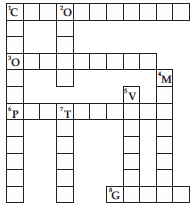
Down
1. Green plastids.
2. Formed by collection of tissues.
4. It separates the contents of the cell from the surrounding medium.
5. Empty structure in the cytoplasm.
7. A group of cells.
